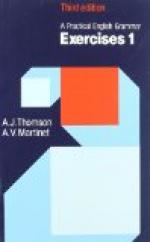CHAPTER VII.
OF PREPOSITIONS
MISUSED PREPOSITIONS.[132]—A writer, in choosing the proper preposition to express his meaning, must rely chiefly on his sense of idiom, that is, his knowledge of English usage, but he may find the following notes helpful.
AMONG, BETWEEN.—“Among is the proper word when the reference is to more than two persons or things, or groups of persons or things; between, when the reference is to two only."[133]
AT, IN.—Before names of places to denote “where,” at is used when the place is so small as to be treated as a mere point, or when, although large, it is viewed as a mere point; in is used when it is desired to make prominent the idea “within the bounds of:” as, “He arrived at Liverpool in the morning and remained in that city two days.” Before the name of the place in which the speaker dwells, if the place is of any size, in is generally preferred to at, unless the place is so remote that it dwindles in the mental vision to a point.
BACK OF.—Back of, though frequently heard in conversation and sometimes seen in print, is not in good use.
BESIDE, BESIDES.—Beside means “by the side of;” besides is now used only in the sense of “in addition to,” “other than:” as, “Who sits beside you?” “Who besides us knows this?”
BY, WITH.—To introduce the agent of an action by is now commonly used; the material instrument or tool is usually introduced by with: as, “Duncan was murdered by Macbeth with a dagger.”
DIFFERENT FROM, DIFFERENT TO.—Different from is preferable to different to and different than.
IN, INTO.—“In implies presence inside of, or within; into implies movement to the inside of. Before a man can move in a room, he must already have moved into it."[134]
IN, ON.—Before names of streets, in implies some reference to surroundings; on is less definite, indicating location only.
ON TO, ONTO.—“Good use does not support either on to or onto."[135]
WAIT FOR, WAIT ON.—To wait for means “to await,” as, “We will wait for you at the corner.” To wait on means “to attend on,” as, “At dinner the women waited on the men.”
[132] “Foundations,” pp. 142-148. [133] Ibid., p. 143. [134] Ibid., p. 145. [135] “Foundations,” p. 146.
EXERCISE LXXXI.
Insert the proper preposition in each blank:—
AMONG, BETWEEN. 1. He divided the apples —— the five boys. 2. There was a generous rivalry —— the two friends. 3. I have no preference —— many of Tennyson’s poems. 4. There is bad feeling —— China and Japan. 5. The money was divided —— the six heirs.




